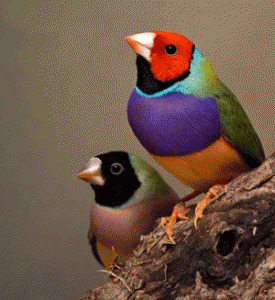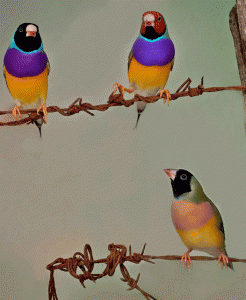

Victorian naturalists, products of their stultifying and prudish age, held birds to be paragons of fidelity and wholesome family values. But the advent of modern DNA analysis showed that when bird-watchers pack up their binoculars and head home for dinner, television and maybe a little intercourse, hens of many – perhaps most – bird species are getting plenty on the side. The varied and subtle extra-pair mating strategies that my biologist colleagues have uncovered in birds over the last twenty years parallel a wealth of disturbing and titillating insights from DNA paternity analysis in humans. Now a new study on the delightful Australian Gouldian finch by Simon Griffith, Sarah Pryke and Bill Buttemer opens a can of wriggly questions about mate choice and monogamy.
Pair-bonded relationships, like those between male and female birds or between men and women only evolve when raising offspring is difficult. In most species, parents lay their eggs and abandon them to their fates. In many fish, and birds like the emu, the female abandons the male to care for the eggs, and goes off in search of other prospects. In most mammals, the dad courts, ejaculates and leaves, playing no further role in his children’s upbringing. But sometimes, bringing up a brood or a family is so tough that it takes the hard work of both a mum and a dad.
That’s only where it begins to get interesting. Evolutionary biologists have recently realised that even when a mummy and a daddy love each other very much, they still have different evolutionary interest. Each parent wants the other to do most of the hard work, and wants to do as little as possible themselves. This idea of sexual conflict neatly parallels the idea of cooperative conflicts recently developed within economics by folks like Nobel-winner Amartya Sen.
Economists used to look at families as entirely cooperative ventures, striving to maximise their joint and mutual happiness and productivity. But in the 1970’s welfare workers, like Adrienne Germain (now president of the International Women’s Health Coalition), realised that ‘every household has two decision makers, not one’. Germain says that when she asked economists to model the different interests of men and women within a household, they told her: ‘Look, Adrienne, if we were to add a second decision maker into our model, the equations would run off the paper. We can’t do it’. To which Germain’s response was ‘Okay, you can’t do it, so think of an alternative, because the reality is that household decisions are a negotiation’[i].
Happily, economists like Sen have found ways to incorporate the different economic interests of husband and wife into their models, and evolutionary biologists have learned to incorporate the different evolutionary interests of males and females into their experiments. As a result, we are poised to rediscover the inner workings of families and relationships – the source of some of our greatest joy, our worst disappointment and often our most tragic conflict[ii].
There may be ‘plenty of fish in the sea’, but when we go fishing, we often come to the realization that all the good ones are taken. As a result, to quote the ‘Stones, ‘You can’t always get what you want’. In a system where folks are mostly monogamous, most of the time, we pair up with somebody who is a balance between what we want and what we can get. It turns out that in that compromise we can end up with a relationship that is not what we need.
Enter the Gouldian finch, a gorgeous but endangered seed-eater from the top end of Australia. Pryke and Griffith have been studying a large captive colony for around seven years, and making regular trips to northern Australia to study them in the field. Most Gouldians have black heads, some have red heads and a very small number have yellow heads. Sarah and Simon have shown that birds prefer mates with the same head color as themselves, and that when there are no same-coloured mates available then they will breed, but at a cost. Around forty percent of sons and 80 percent of daughters from these incompatible matings die- a massive fitness cost of making the wrong mating decision.
Female birds usually choose in which male’s nest to settle down and lay their eggs. Some females get to choose Mr Right, but as the better males get taken, so females have to make do with Mr Good Enough or risk not breeding at all. A female forced to settle for (and mate with) an inferior male is more likely to sneak off and mate with one of the sexier males around, but until now we didn’t know whether these females made their peace with their sub-standard domestic circumstances.

In this week’s issue of Proceeding of the Royal Society of London, Griffith et al show that female Gouldians who end up with the wrong coloured male –because there were none of the right kind left in their aviary, or because they were paired up with only the wrong kind of male – suffer elevated stress for at least as long as the breeding cycle. These females suffered three to four times as much of the stress hormone cortocosterone in their blood when they were coupled with a male of the wrong head color.
Simon tells me “we believe that the elevated level of corticosterone is likely to set females up nicely for all the cool and subtle behavioural and physiological responses that (we see from) females with inferior partners”. Their earlier studies show that females mated to the wrong kind of male cut back on their investment in his chicks. They lay fewer, smaller eggs, don’t feed the chicks as conscientiously, and are much more likely to mate with males other than the one whose nest they are living in. Simon even speculated that “elevated corticosterone might be the infidelity trigger”.
In my field it can be tough to decide how to interpret the parallels between humans and other animals. Sometimes we can make genuine inferences and other times we’re making more speculative connections. Studies on humans can learn from Griffith et al’s paper by asking the same kinds of questions. Like biologists, folks who work on human marriages and parenting arrangements have too easily swallowed the idea that people happily come to terms with their own value on the mating market, so that ‘hot’ hooks up with ‘hot’ and the rest of us find somebody who is satisfyingly equivalent to us in ‘quality’.
As Griffith, Pryke and Buttemer point out in their paper, this is a bit like “assuming that only women as attractive as Angelina Jolie find a man such as Brad Pitt attractive. The reality in that case is that only one very high-quality woman is able to socially pair with Brad Pitt.” For the rest of us, making do with what we can get can stress us out. Making a bad match is a universal recipe for unhappiness and, often, divorce. Perhaps our own stress pathways, triggered by an inappropriate match, might be making us bad parents and leading us toward infidelity. That is a question that will take some careful and ethically tricky research to answer.
………….
Visit Sarah Pryke’s webpage for plenty of news stories and videos on the many excellent Gouldian finch studies that she, Simon and their collaborators have published.
See Jennifer Viegas’ article on this topic at Discovery News
[i] SHARPLES, R. (2003) Transcript of Interview with Adrienne Germain. Population and Reproductive Health Oral History Project. Northampton, MA, Sophia Smith Collection, Smith College.
[ii] Watch for my forthcoming book, Sex, Genes and Rock ‘n’ Roll: How Evolution Shaped the Modern World which I relentlessly plug in these postings, in which I explore sexual conflict and cooperative conflict more thoroughly.
One Reply to “The stress of making a bad match”